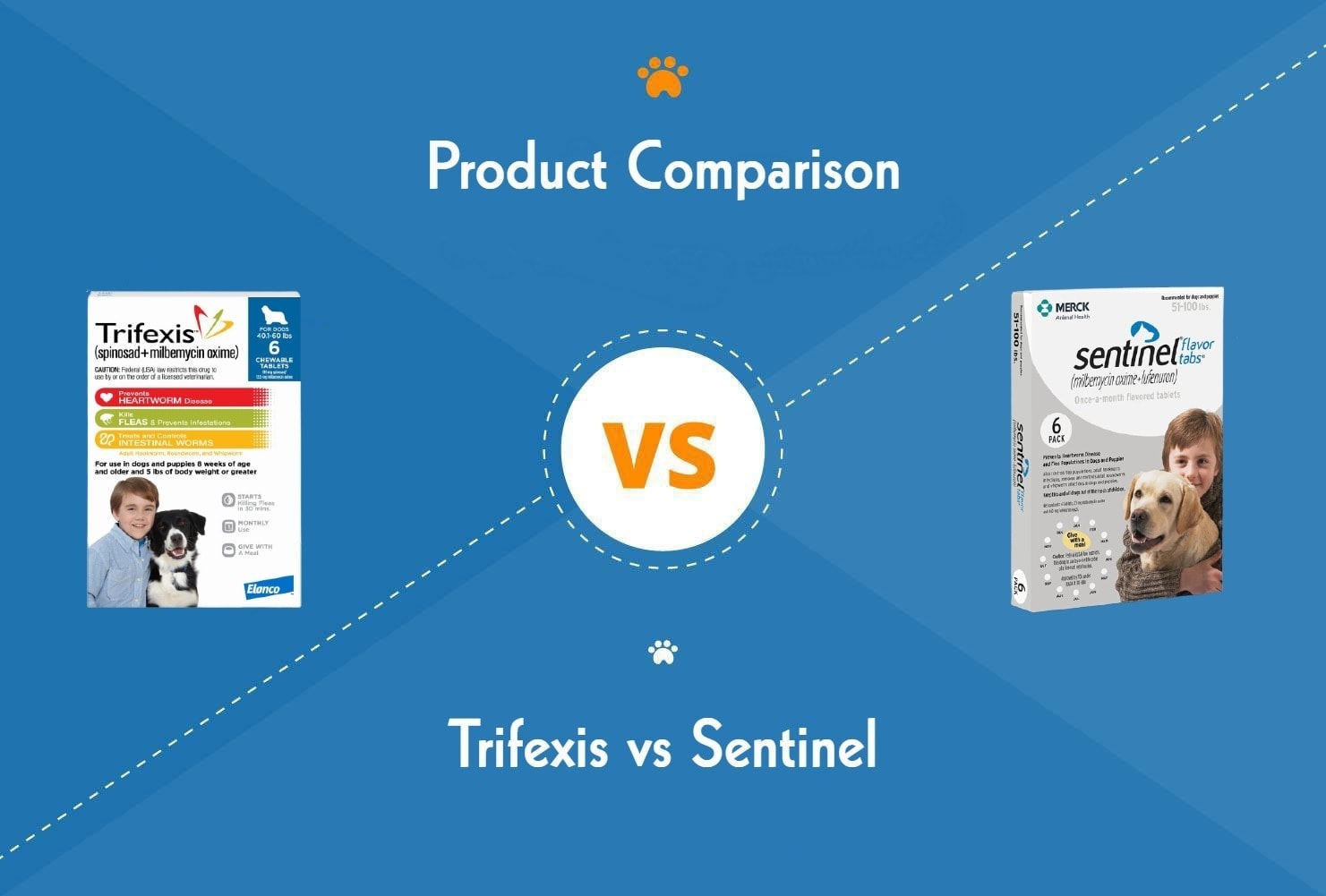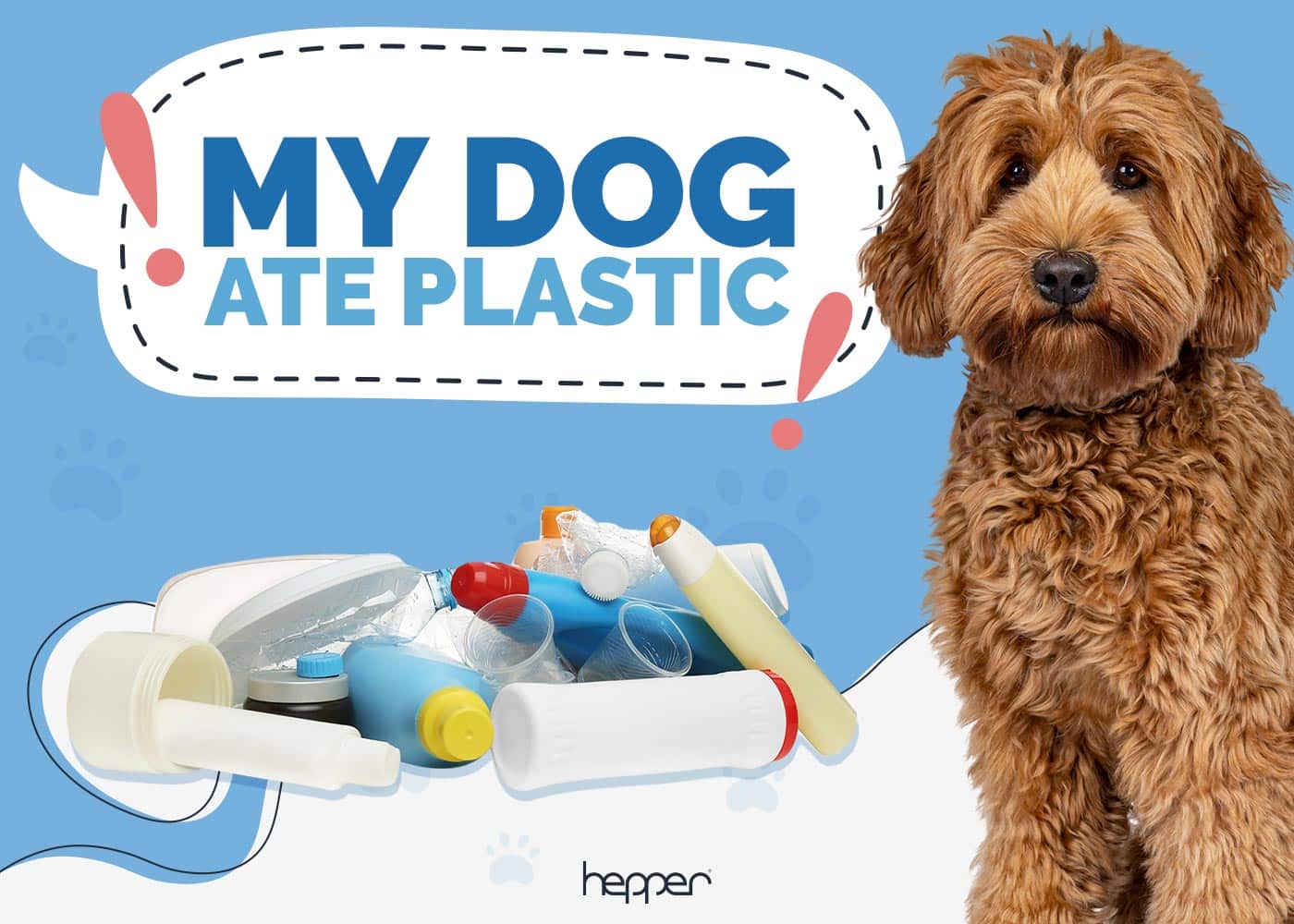Trifexis vs Sentinel: Key Differences (Vet Answer)

Updated on

Click to Skip Ahead
If you’ve been searching for the best flea and worming treatment for your dog, you already know how many different options are out there these days. It’s great to have choices, but with so many different products, it can make it difficult to know which one is right for you and your pet.
In this article, we’re going to look at two different types of monthly tablets: Trifexis and Sentinel. They both treat fleas, heartworms, roundworms, hookworms, and whipworms but have some important differences. We’re going to explore those differences and show you what you need to know when choosing parasite treatment for your canine companion.
- Sentinel is a flavored tablet that treats worms and prevents flea infestations in dogs as young as 4 weeks. It can be given to pregnant and lactating dogs, but it can take time to work.
- Trifexis will start killing fleas within 30 minutes of administering the chewable flavored tablet, but it is not licensed for use in breeding dogs and can only be given to puppies over 8 weeks old.
Trifexis certainly packs a punch in terms of its ability to knock down fleas quickly but retails for around twice the price of Sentinel, which boasts a wider safety margin. This puts Sentinel ahead in terms of value for money, but let’s take a closer look at both products and see how they stack up.
At a Glance

Sentinel and Trifexis are two brands of flea and worming treatments licensed for use in dogs. Both come as palatable tablets, designed to be given every 4 weeks, and when given at that interval, can treat and prevent infection with heartworm, roundworm, hookworm, and tapeworm, as well as eliminate fleas.
- A small, pork liver-flavored tablet
- Active ingredients: Lufenuron with milbemycin oxime
- Licensed for use in dogs over 4 weeks of age and weighing more than 2 pounds
- Licensed for use in breeding males and females
- Licensed for use in pregnant and lactating bitches
- Eliminates fleas by preventing eggs from hatching, stopping the life cycle (does not treat adults or larvae)
- Does not kill adult fleas, so an additional adulticide treatment may be needed in cases of active flea infestation
- May take 2 to 3 months to achieve total flea control
- Must be prescribed by a veterinarian
- A chewable, beef-flavored tablet
- Active ingredients: Spinosad with milbemycin oxime
- Licensed for use in dogs over 8 weeks of age and weighing more than 5 pounds
- Not licensed for use in breeding dogs or pregnant and lactating bitches
- Eliminates fleas by killing adults, preventing them from laying more eggs (does not treat eggs or larvae)
- Kills adult fleas—starts working within 30 minutes, with 100% effectiveness reported within 4 hours
- May take 1 to 3 months to achieve total flea control
- Must be prescribed by a veterinarian
Overview of Trifexis

Trifexis is a beef-flavored, chewable tablet that kills adult fleas, roundworms, whipworms, and hookworms. When used every 4 weeks, as prescribed, it will also treat and prevent heartworm. It contains the insecticide Spinosad as its active ingredient against fleas, with milbemycin oxime as the anthelmintic (worm treatment).
How Does It Work?
The milbemycin in Trifexis alters the permeability of invertebrate muscle cells, leading to paralysis and death of adult roundworms, hookworms, and whipworms, and is considered to be effective against heartworms after three consecutive treatments given 4 weeks apart. Because the worming treatment will only kill adult worms, multiple treatments are always needed in order to eliminate eggs and larvae once they have reached adulthood.
Spinosad acts on the nicotinic acetylcholine receptors to cause tremors, paralysis, and death in fleas, and trials have demonstrated 100% flea death within 4 hours of administration. It aims to achieve flea control by killing adult fleas before they can reproduce, but additional environmental treatments may be needed in the cases of severe flea infestation.
- Kills fleas quickly: Complete eradication of adult fleas on the dog within 4 hours
- Prescription-only treatment: Your dog will be health-checked by a vet to ensure they are fit and healthy before taking the medication
- Chewable tablet: This may be more appealing than non-chewable tablets
- Oral medication: Cannot wash off or stain furniture like a spot-on treatment
- No environmental control of fleas. Relies on killing adults to stop reproduction. Additional environmental treatments may be needed to eliminate eggs and larvae in bedding, clothes, etc.
- A flea needs to bite a dog for it to work
- Chewable tablet: May be harder to disguise in food if a dog doesn’t like the taste
- Cannot be given to pregnant or lactating females
- Safety is not established in reproductive males
- Can only be given to puppies older than 8 weeks and 5 pounds
- Doesn’t work against ticks
- The mode of action of Spinosad has the potential risk of affecting vertebrates, as well as invertebrates
- Not recommended for dogs with a history of seizures
- Higher levels of reported adverse reactions, both clinically and experimentally, including salivation, coughing, tremors, and seizures
Overview of Sentinel

Sentinel is a pork liver-flavored tablet that, when used every 4 weeks, will treat and prevent heartworm and kill adult roundworm, whipworm, and hookworm. It controls flea populations by preventing their eggs from hatching, stopping their life cycle.
How Does It Work?
The anthelmintic in Sentinel is also milbemycin oxime, and its mode of action is the same as that of Trifexis.
The active ingredient for flea control in Sentinel is Lufenuron, an insect development inhibitor. It stops the eggs of any flea affected from developing but has no effect on the adult fleas themselves. Because of this, it may take several generations of fleas to eliminate a flea problem if used on its own. If used with an adulticide treatment, however, the effect will be to kill adult fleas present, as well as prevent their eggs from developing, achieving short-term and long-term flea control.
- Prescription-only treatment: Your dog will be health-checked by a vet to ensure they are fit and healthy before taking the medication
- Because it stops eggs from developing, it controls fleas in the environment, not just on the dog
- The flavored tablet is quite small, making it easier to hide in food
- Can be given to puppies from 4 weeks old and 2 pounds in weight
- Safe to use in breeding dogs and pregnant and lactating females
- Only mild and infrequent side effects were reported experimentally and clinically, including lethargy, vomiting, and diarrhea
- Lufenuron is an invertebrate-specific chemical, so will not have the risk of affecting receptors in vertebrates
- Oral medication: Cannot wash off or stain furniture like a spot-on treatment
- When used alone, it may take up to 3 months to get a good level of flea control
- A flea needs to bite a dog for it to work
- Doesn’t work against ticks
Trifexis and Sentinel: What Are the Differences?
Performance
Edge: Varies, depending on the desired result and various factors
In terms of a quick fix against fleas that also takes care of intestinal worms and heartworms, Trifexis is the clear winner, with fleas starting to die within 30 minutes of dosing. But, if it’s a long-term investment in the control of fleas on your dog and their environment, Sentinel will give you this.
If you have a big flea infestation on your dog and in your home, either product will help you get control, but both would need to be used with additional products:
- Trifexis: You will need something to treat the environment, as Trifexis will only kill the adult fleas on the dog, and you may need to continue with environmental treatment long-term if you have a severe problem
- Sentinel: You will need an adulticide treatment to kill any adult fleas present and something to treat the environment, but once the initial infestation is controlled, Sentinel should keep fleas at bay
Talk to your veterinarian about which products will be safe to use alongside Trifexis and Sentinel.
Price
Edge: Sentinel
Sentinel retails at around half the price of Trifexis for a 6-month supply across several sites, which, in today’s climate (or any climate for that matter!), is a huge tick in Sentinel’s column.

Safety
Edge: Sentinel
The side effects reported from experimental testing and those in customer reviews indicate that Trifexis has a higher incidence of more significant side effects, including seizures. This may be due to the fact that although Spinosad has a high selectivity for insect muscle tissue, there is no proof that it won’t affect vertebrates as well.
Range
Edge: Sentinel
Although not specifically contraindicated in them, Trifexis has not been licensed for use in breeding dogs or pregnant and lactating females. Sentinel, on the other hand, is licensed as safe in all of the above.
Sentinel can also be used in puppies twice as young and half the size as those that can be treated with Trifexis.
Presentation
Edge: Varies, depending on dog’s preference
Sentinel comes in a small, pork liver-flavored tablet, and Trifexis in a beef-flavored chew. This all comes down to dog preference and food allergies. If your dog has a significant food allergy, it is worth noting the ingredient used in any flavored medication.
Some dogs prefer a chewable tablet, taking them like a delicious treat; however, if they don’t like the taste, chews can be harder to hide or get your dog to swallow.

What the Customers Say
A quick search through the reviews on these products reveals a few areas that are repeated:
Palatability
Several reviewers criticized the palatability of both products, but more complained about the fact that the chewable Trifexis was disliked by their dog and then difficult to get them to take it because of its size.
Effectiveness
Reviewers generally raved about the effectiveness of Trifexis against fleas. There were quite a lot of complaints that Sentinel was not getting rid of fleas; however, due to the way it works, it is not unexpected that pet owners won’t see an immediate elimination of fleas. This is something that should be made quite clear on the packaging rather than just the fine print.
There were a number of reviews on both products reporting that their dog had tested positive for heartworm despite being on Trifexis/Sentinel. There are always going to be some outliers in terms of efficacy, but the heartworm prevention/treatment claim only applies if the strict 4-weekly dosage schedule is followed.
Side Effects
Both products had some feedback about the safety of the products. For Sentinel, the side effects mentioned were lethargy, vomiting, or diarrhea, which is consistent with the potential side effects listed on the data sheet.
Similarly, some Trifexis users reported some trembling, twitching, salivating, and seizures in their dogs after dosing.
Conclusion
It seems pretty clear from both the data on these products and from the price and customer reports that Sentinel is the clear winner here.
Trifexis will kill the fleas on your dog very quickly, but that is where it loses its edge.
Sentinel treats worms as efficiently as Trifexis, keeps flea populations under control both on your dog and their immediate environment, is half the price of its competitor, appears to be a far safer product, and is able to be used on a wider range of dogs.
The need to use an additional product to kill adult fleas at the start of treatment seems to be a fair price to pay for a safer, more long-term solution.
The main thing to remember with both products is that for them to be effective, they need to be given at the recommended interval: every 4 weeks. Not doing so opens you up to repeat flea infestations and heartworm infections.
- Related Read: Trifexis vs. Heartgard Plus: We Asked a Vet















